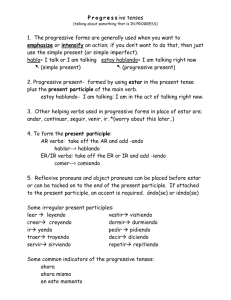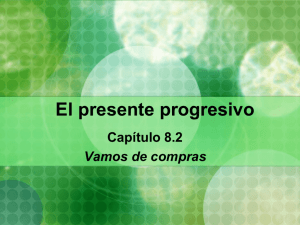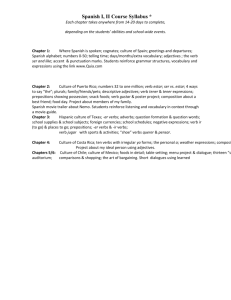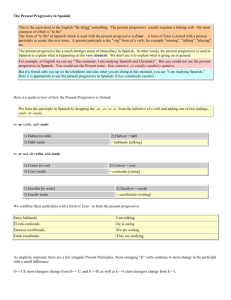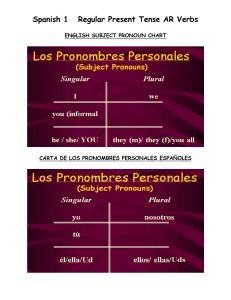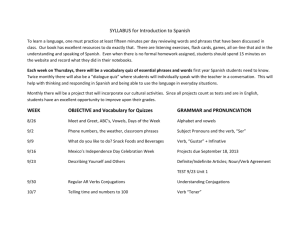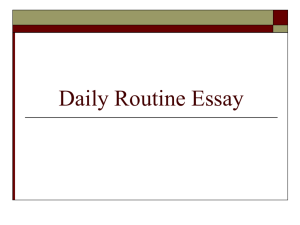Of current lesson in
advertisement
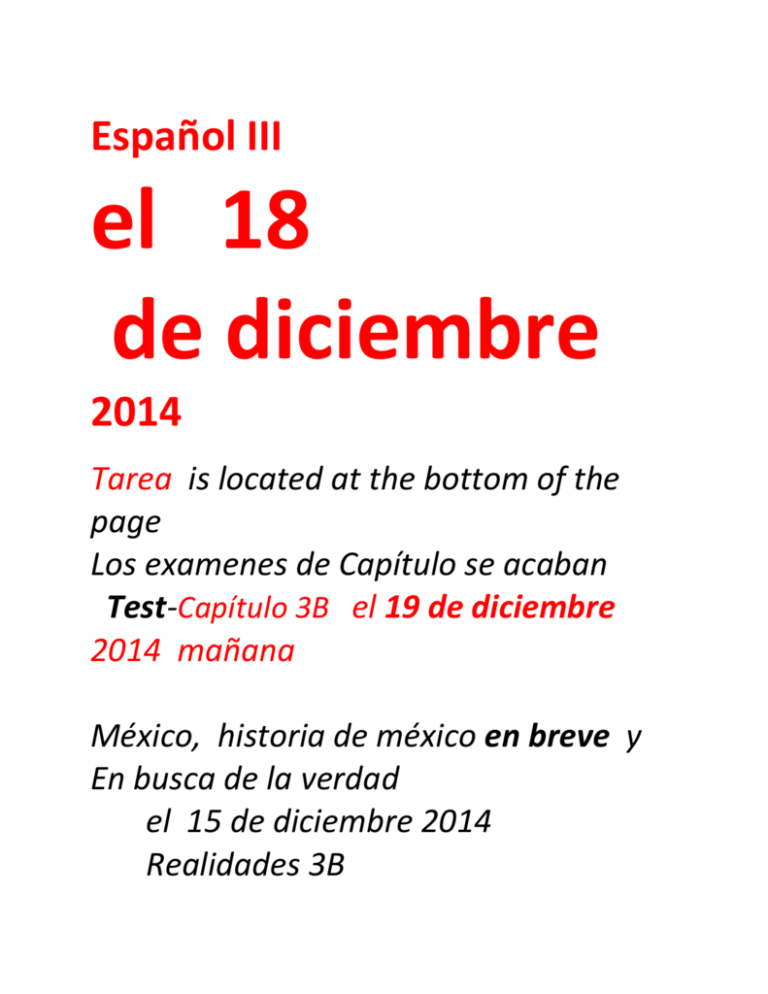
Español III el 18 de diciembre 2014 Tarea is located at the bottom of the page Los examenes de Capítulo se acaban Test-Capítulo 3B el 19 de diciembre 2014 mañana México, historia de méxico en breve y En busca de la verdad el 15 de diciembre 2014 Realidades 3B META 1. Vocabulario del CENTRO 2. Palabras importantes 3. El Presente Progresivo 4. Mandato- Tú Affirmativo Regulares e irregulare 5. La Lección a. A Primera Vista páginas 158-159 b. Manos a la obra página 162 Las Glorietas Actividad 12 ¡A Lavar! Página 138. c. Direct Object Pronouns página 166 d. Actividad 12 TAREDE OTRA VEZ e. Irregular Tú form commands página 168 Los consejos de una amiga Actividad 16 f. Repasos y verbos usados por hacer la actividad 5. ¿Comprendiste? Página 161 Realidades 2 Remember- Test on material covered this week, Friday or Monday Capítulo 3B el Camión la avenida el semáforo la plaza zocalo in México fuente el tráfico la estatua la señal de parada peatón peatonál el cruce de la calle el puente estrecho estrecha ancho ancha rápido despacio círculos glorietas esquina una cuadra manzana cruzar doblar sigue adelante sigue derecho manejar Conducir Guiar ten cuidado Cuidar permiso de manejar poner una multa peligroso pasar por quitar QUITARSE carretera Direct Object Pronouns otra vez Me te lo la le nos os los las Affirmative informal (tú) commands Regular Tú commands are the singular form of informal commands. To tell a friend, family member, classmate, child, or pet to do something, use the affirmative tú command. To tell one of those same people not to do something, use the negative tú command. This article covers the affirmative informal command (informal imperative) in all its forms. Compra (tú) los libros. (Buy the books.) – affirmative No camines (tú) en el césped. (Don’t walk on the grass.) – negative Affirmative Informal Tú Command Forms For the familiar affirmative TÚ commands, you will simply use the 3rd person singular form of the present indicative. -AR verbs: Add the 3rd person singular ending –a to the stem (Comprar) Compra la camisa. (Buy the shirt.) -ER verbs: Add the 3rd person singular ending –e to the stem (Aprender) ¡Aprende español! (Learn Spanish!) -IR verbs: Add the 3rd person singular ending –e to the stem (Escribir) ¡Escribe el ensayo! (Write the essay!) For verbs with stem changes or spelling changes in the present tense, the stem or spelling change still applies. (Cerrar) Cierra la puerta. (7loset he door.) (Mover) Mueve esas sillas. (Move those chairs.) (Incluir) Incluye tu información aquí. (Include your information here.) Irregular Affirmative Informal Tú Commands All irregular 3rd person singular present indicative verbs keep that same irregularity in the affirmative informal command except the following 8 verbs which have a special irregular form in the affirmative command. Decir Di salir sal hacer haz ser ir sé ve tener ten poner pon venir ven ¡Ven acá! Come here! ¡ Véte! Get out La tarea? Házla ahora! Be good! ¡Sé bueno! ¡Díme! Tell me! ¡Sal! Leave! Pronoun Placement with Commands Pronoun placement: the pronoun is attached to the end of affirmative commands and the verb carries a tilde to maintain its original stress. ¡Háblame! Punctuation to the Rescue! Because the informal tú command (imperative) is the same conjugation form as the 3rd person singular, it is helpful to include exclamation points to indicate urgency or the name of the person you are commanding followed by a comma. Without the comma, your sentence is just the 3rd person singular present indicative. Compare the following sentences written with different punctuation: • Compra la camisa. (She buys the shirt.) - present indicative • ¡Compra la camisa! (Buy the shirt!) - informal imperative • Alicia compra la camisa. (Alicia buys the shirt.) - present indicative • Alicia, compra la camisa. (Alicia, buy the shirt.) - informal imperative Present Progressive Tense Present Progressive The present progressive is formed by combining the verb "to be" with the present participle. (The present participle is merely the "-ing" form of a verb.) I am studying. I am studying with María. In English, present progressive can be used to describe what is happening now, or what will happen in the future. I am studying now. I am studying with María tonight. In Spanish, the present progressive is only used to describe an action that is in the process of taking place. It is not used for future actions. I am studying now. (use present progressive) I am studying with María tonight. (do not use present progressive) To form the present progressive in Spanish, combine a form of "estar" with the present participle. Estoy hablando. I am speaking. Juan está comiendo. John is eating. María está escribiendo una carta. Mary is writing a letter. In order to form the present progressive, you must know how to conjugate the verb estar, and how to form the present participle. You already know how to conjugate the verb estar: estar estoy estás está estamos estáis están To form the present participle of regular -ar verbs, add -ando to the stem of the verb. hablar: hablando (hablar - ar + ando) trabajar: trabajando (trabajar - ar + ando) estudiar: estudiando (estudiar - ar + ando To form the present participle of regular -er and -ir verbs, add iendo to the stem of the verb. comer: comiendo (comer - er + iendo) hacer: haciendo (hacer - er + iendo) vivir: viviendo (vivir - ir + iendo) escribir: escribiendo (escribir - ir + iendo) To form the present participle of -ir stem changing verbs, change e:i and o:u in the stem, and then add -iendo to the stem of the verb. servir: sirviendo pedir: pidiendo decir: diciendo dormir: durmiendo morir: muriendo poder: pudiendo Sometimes when forming the present participle it is necessary to change the spelling of a word so that it agrees with the way it is pronounced. We call this an "orthographic" change. Here are some common examples: caer: cayendo creer: creyendo huir: huyendo ir: yendo influir: influyendo oír: oyendo traer: trayendo leer: leyendo seguir: siguiendo The following examples illustrate the rules for forming the present participle. hablar: hablando (-ar) comer: comiendo (-er) vivir: viviendo (-ir) decir: diciendo (e:i) dormir: durmiendo (o:u) leer: leyendo (orthographic) seguir: siguiendo (orthographic) To form the present progressive, simply conjugate the verb estar to agree with the subject of the sentence, and follow it with the present participle. Juan está comiendo pan. John is eating bread. María y Carmen están hablando con nosotros. Mary and Carmen are speaking with us. Remember, only use the present progressive for actions that are "in progress." Compare the uses of the present indicative with the uses of the present progressive. Estudio español. (Present Indicative) I study Spanish. I am studying Spanish (these days). I do study Spanish. Estoy estudiando español. (Present Progressive) I am studying (right now, at this moment) Spanish. It is important to remember that you would never use the present progressive to say something like "We are going to Spain this summer." Use present progressive only for actions that are "in progress." Spanish Present Progressive ~ Present Continuous The Spanish present progressive, or present continuous, is very similar to its English counterpart (to be + -ing). In both languages, the present progressive expresses an inprogress action, with an emphasis on its current, temporary aspect. No estamos mirando la televisión. We're not watching television. Estoy trabajando; no puedo I'm working; I can't go out. salir. ¿Por qué no estás haciendo Why aren't you paying caso del profesor? attention to the teacher? In English, the present progressive can also be used for something that will happen in the future. Not so in Spanish. This use of the English present progressive is expressed in Spanish with the simple present, future, or near future. I'm going to the bank later. Voy Iré } al banco más tarde. Voy a ir He's leaving tomorrow. Sale Saldrá } mañana. Va a salir MORE REVIEW OF THE PRESENT PROGRESSIVE The Spanish present progressive is usually formed with the present tense of estar + gerund of the action verb. Estoy leyendo I am reading Estás hablando You are speaking Está llorando He is crying There are five other verbs which can replace estar and add a different nuance to the present progressive: andar to be (in the process of) doing something Anda buscando sus llaves. He's looking for his keys. ir to start/be gradually doing something Voy comprendiendo la verdad. I'm starting to understand the truth. llevar to have been doing something (English present perfect progressive) Llevo dos años trabajando I've been working here aquí. for two years. seguir to go on/keep/continue doing something Sigue lloviendo. It's still raining. venir to have been doing something (English present perfect progressive) Es lo que vengo diciendo. That's what I've been saying. 1. En busca de la verdad Review the historia breve de México Capítulo 3A y En Busca de la verdad Capítulo 3A ¿Qué hiciste ayer? Parte II de esta intensa lección consta de examinar los detalles de EN BUSCA DE LA VERDAD... consta de la cultura y la historia de México en breve para comprender esta grande novela. Un Conocimiento de la historia de México es importante para comprender lo que pasa con los carácteres de la novela. Así es que se presenta la historia de México en breve La Historia de México en breve El Periodo de Los Indiginas 1519 Before the Spanish arrival in , Mexico was occupied by a large number of Indian groups with very different social and economic systems. In general the tribes in the arid north were relatively small groups of hunters and gatherers who roamed extensive areas of sparsely vegetated deserts and steppes. These people are often referred to as Chichimecs, though they were a mixture of several linguistically distinctive cultural groups. In the rest of the country the natives were agriculturalists, which allowed the support of dense populations. Among these were the Maya of the Yucatan, Totonac, Huastec, Otomi, Mixtecs, Zapotecs, Tlaxcalans, Tarascans, and Aztecs. A number of these groups developed high civilizations with elaborate urban centers used for religious, political, and commercial purposes. The Mayan cities of Chichen Itza, Uxmal, and Palenque, the Aztec capital of Tenochtitlan, Tzintzuntzan of the Tarastec, and Monte Alban of the Zapotecs are examples. By AD 1100 the Toltecs had conquered much of central and southern Mexico and had established their capital at Tula in the Mesa Central. They also built the city of Teotihuacan near present-day Mexico City. At about the same time, the Zapotecs controlled the Oaxaca Valley and parts of the Southern Highlands. The cities they built at Mitla and Monte Alban remain, though they were taken over by the Mixtecs prior to the arrival of the Spanish. When the Spanish arrived in central Mexico, the Aztecs controlled most of the Mesa Central through a state tribute system that extracted taxes and political servility from conquered tribal groups. The Aztecs migrated into the Mesa Central from the north and fulfilled a tribal prophesy by establishing a city where an eagle with a snake in its beak rested on a cactus. This became the national symbol of Mexico and adorns the country's flag and official seal. The Aztecs founded the city of Tenochtitlan in the early 1300s, and it became the capital of their empire. The Tlaxcalans to the east, the Tarascans on the west, and the Chichimecs in the north were outside the Aztec domain and frequently warred with them. The nation's name derives from the Aztecs' war god, Mexitli. Spanish Conquest LLegan los Españoles From the time of Hernando Cortez's conquest until 1821, Mexico was a colony of Spain. Cortez first entered the Valley of Mexico on the Mesa Central in 1519 after marching overland from Veracruz, the town he had founded on the Gulf Coastal Plain. With fewer than 200 soldiers and a few horses, the initial conquest of the Aztecs was possible only with the assistance of the large Indian armies Cortez assembled from among the Aztecs' enemies. After a brief initial success at Tenochtitlan, the Spanish were driven from the city on the Noche Triste but returned in 1521 to destroy the city and to overwhelm the Aztecs. Within a short time the rest of central and southern Mexico and much of Central America were conquered from Mexico City. The Spanish usurped the Indian lands and redistributed them among themselves, first as encomiendas, a system of tribute grants, and later as haciendas, or land grants. During the early contact with Indians, millions died from such European diseases as measles and smallpox, for which the natives had no immunity. Central Mexico did not regain its pre-Columbian population numbers until perhaps 1900. Leyenda Negra Independence Along with other Spanish colonies in the New World, Mexico fought for and gained its independence in the early 1800s. On Sept. 16, 1810, in the town of Dolores Hidalgo, the priest Miguel Hidalgo y Costilla rang his church's bells and exorted the local Indians to "recover from the hated Spaniards the land stolen from your forefathers. . ." This is celebrated as Mexican Independence Day. Padre Hidalgo was hanged in July 1811. Battles for Independence from Spain Hidalgo was succeeded by Jose Maria Morelos y Pavon, another parish priest but a more able leader than his predecessor. Morelos called a national congress, which on Nov. 6, 1812, officially declared Mexico to be independent from Spain. Morelos was executed by a Spanish firing squad in 1815, but his army, led by Vicente Guerrero, continued fighting until 1821. Because of weaknesses and political divisions in Spain, the revolutionary movement gained strength. Agustin de Iturbide, a royalist officer, joined forces with Guerrero and drafted the Plan of Iguala, which provided for national independence under a constitutional monarchy--the Mexican Empire. Not surprisingly, Iturbide was crowned emperor of Mexico in July 1822, and the newly formed empire lasted less than a year. Iturbide was exiled from the country but returned and was executed. General Antonio Lopez de Santa ANA then emerged as the dominant political force for some 30 years. Santa Anna was president of Mexico when Texas MexicanAmerican War of 1846 revolted and during the Benito Juarez Years After nearly a half century of independence, Mexico had made relatively little economic or political progress, and the peasantry continued to suffer. In 1858 Benito Juarez, a Zapotec from Oaxaca, became president. He attempted to eliminate the role of the Roman Catholic church in the nation by appropriating its land and prerogatives. In 1859 the Ley Lerdo was issued-separating church and state, abolishing monastic orders, and nationalizing church property. Juarez had anticipated that Indians and peasants would reacquire the 50 percent of the nation's land formerly held by the church, but the properties were quickly purchased by the elite. Because of the many years of economic and political Mexico was financially insolvent. chaos that had elapsed, Juarez and Suspension of payment on foreign loans In 1861 Juarez announced a suspension of payment on foreign loans, and the British, Spanish, and French occupied Veracruz in order to collect the Mexican debts. The British and Spanish quickly withdrew, but France overthrew the Mexican government and in 1864 declared Mexico an empire with Maximilian I of Austria as emperor. During the war with the French, the Mexican armies won a major battle on May 5, 1862, despite being severely outnumbered and underarmed. That victory is celebrated as Cinco de Mayo, a national holiday. Because of its own Civil War, the United States was unable to enforce its Monroe Doctrine, which prohibited European involvement in the Americas. At the close of the Civil War, however, the United States threatened to send troops into Mexico, and the French army withdrew from the country. Maximilian was executed by the Mexicans in 1867. After the fall of the French and several years of turmoil, Porfirio Diaz emerged to become president in 1877 and, except for four years, ruled as an absolute dictator until 1910. During his reign Diaz encouraged foreign investment and attempted to modernize the nation. He helped to increase the GDP fivefold, expanded both exports and imports, saw gold and silver production increase from 25 million to 160 million dollars a year, and built more than 15,000 miles (24,000 kilometers) of railway. During this same period Diaz lined his pockets and gave away huge concessions of land to friends and foreign speculators. By 1910 more than 95 percent of rural families had become landless--debt peons because of government expropriation of communally held farm villages. Mexican Revolution Porfirio Díaz Benito Juarez Maximiliano I México Because Diaz had surrounded himself with friends and cronies who gained economic and political power, there was little opportunity for outsiders in the process even if they were upper-class Mexicans. Francisco Madero, born into a wealthy mining and ranching family of northern Mexico, is credited with instigating the Mexican Revolution. After the fraudulent election of 1910, Madero led a revolutionary movement that in 1911 captured the isolated border city of Ciudad Juarez. An old man in ill health, Diaz was forced to resign, and Madero was elected president on a platform promising social reform. Madero was idealistic but politically inept. As a result his presidency was short-lived and chaotic. Felix Diaz, Porfirio's nephew, and Gen. Victoriano Huerta joined together in a rebellion that ousted Madero. He and his vice-president, Pino Suarez, were executed by the military in February 1913. Huerta became president, but counterrevolutions broke out in the north. They were led by Gen. Venustiano Carranza, a follower of Madero and governor of Coahuila, with Pancho Villa and Gen. Alvaro Obregon. Peasants in the south, disillusioned with Madero's ineffectiveness, rallied behind the charismatic Indian revolutionary Emiliano Zapata. While the northern revolutionaries were largely interested in access to power, Zapata and his followers, the zapatistas, demanded land and liberty for the peasantry. During the next few years disorder and chaos reigned. In 1915 Carranza overthrew Huerta to became president, but in the process he alienated Villa, among others. Zapata was killed shortly after Carranza came to power, but his ideal of agrarian reform became a cornerstone of the revolution. Villa returned to Chihuahua and raided border towns in the southwest- ern United States, including Columbus, N.M., where a number of Americans were killed. American Gen. John J. Pershing was sent into Mexico to capture Villa but was unsuccessful. (See also Villa, Pancho; Zapata, Emiliano.) The major accomplishment of the Carranza period was the Constitution of 1917, which sought to destroy the feudalism that had existed in Mexico for 400 years. After Carranza's assassination in 1920, General Obregon ascended to the presidency. A strong individual, he was both willing and able to push through social reforms. His successor in 1924 was Gen. Plutarco Elias Calles, a longtime political ally. Calles was vigorously antichurch and was also unfriendly to foreign capital investment. Only through diplomatic intervention was Calles persuaded to reopen churches that had closed and to become less hostile to the foreign governments he had alienated. Obregon was elected to a second term in 1928 but was assassinated that same year. PRI National Revolutionary Party Calles, who had founded the National Revolutionary party, the predecessor of the Institutional that still controls the nation Revolutionary party (PRI) , filled the office of interim president with three successive puppet presidents. Some interesting modern history Peaceful Reforms The election of Gen. Lazaro Cardenas in 1934 changed the politics of the nation. Cardenas expelled Calles and developed a vigorous six-year plan to modernize the country. He redistributed more land than did all of his predecessors combined, built rural schools, nationalized the petroleum industry and strengthened the unions. Miguel Aleman Valdes, president from 1946 to 1952, was responsible for massive public-works projects, including irrigation schemes in the northwest and hydroelectric power in the south. Luis Echeverria Alvarez (1970-76) devalued the peso after nearly 25 years of parity with the United States dollar. Jose Lopez Portillo (1976-82) directed the frantic economic growth of the oil boom. Miguel de la Madrid Hurtado (1982-88) inherited an economy that had been transformed by a rapid decrease in international oil prices as well as huge foreign debts. In July 1988 the PRI candidate Carlos Salinas de Gortari was elected president in a vote marred by charges of widespread fraud. In 1991, President Salinas ordered the immediate closing of Mexico City's largest governmentoperated refinery in a move to combat the city's air- pollution crisis. The giant refinery would be replaced by public parks and green spaces. Salinas was succeeded in 1994 by Ernesto Zedillo Ponce de Leon, who was elected after the leading candidate, Luis Donaldo Colosio, was assassinated. In July 1996 Zedillo and the country's main opposition parties signed a landmark agreement toward political reform. The pact eliminated the PRI's control of election procedures and ballot counting and placed limits on campaign spending. The agreement added 17 new amendments to Mexico's constitution. Sixty-eight years of uninterrupted legislative rule by PRI came to an end in July 1997 as Mexican voters handed control of the country's lower house of parliament to two opposition parties nominally allied against the PRI. While the PRI won the largest individual share of the vote, finishing with approximately 39 percent of the vote, it failed to win an independent majority in the lower house for the first time since 1929. The National Action party (PAN) finished second in the election, capturing 27 percent of the vote, and the Party of the Democratic Revolution (PRD) won nearly 26 percent of the vote. Political analysts were nearly unanimous in stating that the election results indicated that the Mexican political system had begun to move away from thinly veiled one-party rule and toward genuine multiparty democracy. Nowhere was the changing political atmosphere more evident than in Mexico City, where PRD leader Cuahtemoc Cardenas Solorzano won a landslide victory in the mayoral race. Some Recent Relations with the United States Relations between the United States and Mexico fluctuated in the 20th century. A long-standing border dispute was settled in 1963, and in 1992 the two countries, along with Canada, signed the broadest trade agreement ever reached between them. The continent-wide North American Free Trade Agreement (NAFTA) went into effect in 1994. In addition, the United States and Mexico have worked cooperatively to deal with the flow of illegal narcotics traffic from Mexico to the United States. The question of illegal The question of illegal immigration and the treatment of illegals in the United States is also a source of irritation between the nations. Unrest in Chiapas Tensions between pro-government paramilitary forces and the anti-government Zapatista National Liberation Army (EZLN) exploded during the first two weeks of January in 1994, when EZLN guerrillas staged an uprising throughout Chiapas in protest against the Mexican government's treatment of Mexico's large but impoverished Indian community. The 1994 uprising left at least 140 people dead, and it sparked an ongoing struggle that raged throughout the southern state of Chiapas and claimed between 300 and 600 lives in the ensuing years. In December 1997 the village of Acteal in Chiapas became the site of one of the bloodiest massacres in recent Mexican history, as an armed paramilitary group slaughtered at least 45 people and wounded dozens more. Although the motive for the attack, as well as the identities of the perpetrators, remained unclear, villagers from Acteal suggested that pro-government guerrillas had staged the attack to retaliate for Acteal's support of the EZLN, noting that Acteal's villagers had been strong supporters of the anti-government peasant rebellion that began in Chiapas in 1994…………….. Poncho villa 1. Cultura, historia y Conocimiento de las ciudades de En busca de la verdad 2. Guanajuato México 3. San Miguel de Allende, México 4. San Antonio, Texas 5. El museo de Momias de Guanajuato Capítulo 3A Gramática El Pretérito The Preterite tense is used to indicate a completed action in the past. something that was completed-finished in the past Verbos regulares -AR -é -aste -ó -amos -asteis -aron Verbos -er e -ir regulares -í -iste -ió -imos -isteis -ieron ______________________________________ Verbos irregulares IRREGULAR CASES IN PRETÉRITO Case I irregular below DAR Di Diste Dio dimos disteis dieron VER Vi Viste Vio Vimos Visteis Vieron Case II irregular Caer Caí Caíste Cayó Caímos Caísteis Cayeron. OIR Oí Oíste Oyó Oímos Oísteis Oyeron CREER Creí Creíste Creyó Creímos Creísteis Creyeron LEER Leí Leíste Leyó Leímos Leísteis leyeron Case II also has- All –uir verbs Construir Influir..... Construir Construí Construíste Construyó Construímos Construísteis Construyeron Case III SER AND IR Fui Fuiste Fue Fuimos Fuisteis Fueron Ser Fuí Fuiste Fué Fuimos Fuisteis Fueron JOTA group Case IV Jota group All –cir verbs take the “J” Decir Dije Dijste dijo dijimos dijisteis dijeron TRAER goes with the case IV verbs Traje Trajiste Trajo Trajimos Trajisteis Trajeron Case V ESTAR “V” group TENER Estar ESTUVE ESTUVISTE ESTUVO ESTUVIMOS ESTUVISTEIS ESTUVIERON ANDAR ANDUVE ANDUVISTE ANDUVO ANDUVIMOS ANDUVISTEIS ANDUVIERON ANDAR TENER TUVE TUVISTE TUVO TUVIMOS TUVISTEIS TUVIERON Case VI Los independientes Poner Puse Pusiste Puso Pusimos Pusisteis Pusieron Poder Pude Pudiste Pudo Pudimos Pudisteis Pudieron Venir Vine Viniste Vino Vinimos Vinisteis Hacer Hice Hiciste Hizo Hicimos Hicisteis Hicieron Saber: to know a fact Not used in conversation In spoken Spanish it is used to mean “to have found out....!” Supe Supiste Supo Supimos Supisteis supieron knowing is a process Saber- In order to say that you “knew....something” you must use th eimperfect tense form of the verb Sabía Sabías Sabía Sabíamos Sabíais sabían Yo no sabía la respuesta. Querer - to want You can not use the preperite form of the verb QUERER since ¨wanting¨ implies an on going sense of desire...... In conversational Spanish you must use the Imperfect form of the conjugation to indicate “wanting...or wanted” Preterite form of the verb Quise Quisiste Quiso Quisimos Quisisteis Qusieron QUERER In spoken Spanish this means to have refused when the word NO comes before each conjugate. Yo no quise ir. I refused to go. No qusimos ir de compras.We refused to go shopping. No quise No quisiste No quiso Ni quisimos No quisisteis No quisieron To expres “I wanted, you wanted, he/she wanted....” you must use the imperfect form of the verb querer. Quería Querías Quería Queríamos Queríais Querían Yo quería estudiar en la biblioteca. I wanted to study in the library. Dormir Dormí Dormiste Durmió Dormimos Dormisteis Durmieron PEDIR Pedí Pediste Pidió Pedimos Pedisteis Pidieron Other e to i stem-changing verbs..... Servir reir pedir dormir sonrei......... ________________________________________ Case VIII -Car qué -Gar GUÉ -Zar CÉ in the yo form Tocar Toqué Tocaste Tocó Tocamos Tocasteis tocaron -GAR verbs LLEGAR Llegué Llegaste Llegó Llegamos Llegasteis llegaron -ZAR verbs Empezar Empecé Empezaste empezó Empezamos Empezasteis empezaron Don´t forget HOME JOURNALS 5 to 10 minutes - at least 5 minutes per nightOf current lesson in HOME JOURNALS!!! Monday-Friday !!! REVIEW THE VERBS IN THE VERB PACKET! TAREA Realidades 3B El 15 de diciembre 2014 En Busca de la TAREA pagina 152 A y B Para martes que viene Copy the questions and write out the answers please Full heading please ¡¡PARA LUNES!! verdad
